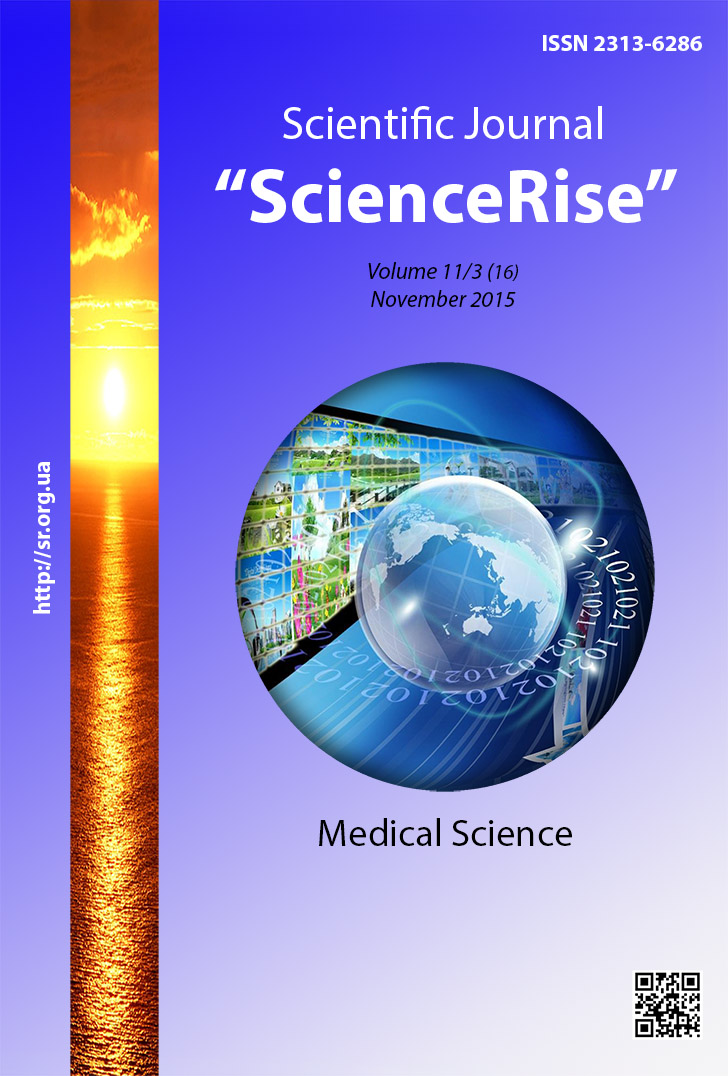Influence of beta-adrenoblockers on structural-functional heart indices in patients with acute q-wave myocardial infarction
DOI:
https://doi.org/10.15587/2313-8416.2015.53930Keywords:
myocardium infraction, heart aneurism, heart rhythm variability, daily profile of arterial pressure, postinfraction remodelingAbstract
The problem of myocardium infraction (MI) remains actually. An early postinfraction period is characterized with intensive remodeling of the left ventricle (LV) and high risk of dangerous complications that is ten times more than the monthly number of complications during the next year. The aim of research was the study of an influence of beta-1 adrenoreceptors on the heart rhythm variability, ectopic heart activity, daily profile of arterial pressure, postinfraction remodeling in patients with an acute Q-myocardium infraction.
Methods. There were examined 235 patients with Q-myocardium infraction. There was evaluated the risk of forming LV aneurism, dynamic indices of combined daily monitoring of arterial pressure and electrocardiogram, echocardiography under influence of the complex treatment using beta-1 adrenoreceptors blockers.
Results. Under an influence of treatment there was established the growth of temporal indices of the heart rhythm variability (HRV), spectral indices that present the parasympathetic influence on the background of decrease of the spectral components of sympathetic origin and mean HR, decrease of ectopic heart activity, normalization of daily profile of arterial pressure, improvement of systolic and diastolic function of LV.
Conclusions. The use of beta-1 adrenoreceptors in the complex treatment of patients with acute Q-MI decreases the risk of forming LV aneurism, favors an improvement of HRV indices, ectopic heart activity, daily profile of arterial pressure, intracardiac hemodynamics
References
Informaciinii buleten VOOZ [Information bulletin IHO] (2011). 317.
Kovalenko, V. M., Kornatskii, V. M. (Eds) (2013). Regionalni mediko-socialni problemi khvorob sistemi krovoobihu. Dinamika ta analiz: posibnik. [Regional medic social problems of circulation system. Dynamics and analysis: textbook]. Kyiv, 240.
Bahrii, A. E, Lukashenko, L. V., Yakovenko, V. G. (2007). Selektivnyi antahonist aldosterona Inspra (Eplerenon) v lechenii bolnykh, perenesshikh infarkt miokarda [Selective aldosterone antagonist Inspra (Eplerenone) in treatment of patients after myocardial infarction]. Medicina neotlozhnykh sostoianii, 1 (8), 63–68.
Ushakov, A. V., Haharina, A. V. (2013). Rehuliacia izmenenii nesokratitelnykh elementov serdechnoi myshcy pri razvitii infarkta miokarda [Regulation of changes of noncontractile elements of heart muscle in development of myocardial infarction]. Serce i sudyny, 3, 118–124.
Solieiko, O. V. (2008). Klinichna evoliucia khronichnoi postinfarktnoi aneurysmy sercia [Clinic evolution of chronic postinfarction heart aneurysm]. Mystectvo likuvannia, 5 (51), 60–64.
Fox, K., Ferrari, R., Tendera, M., Steg, P. G., Ford, I. (2006). Rationale and design of a randomized, double-blind, placebo-controlled trial of ivabradine in patients with stable coronary artery disease and left ventricular systolic dysfunction: the morBidity-mortality EvAlUaTion of the If inhibitor ivabradine in patients with coronary disease and left ventricULar dysfunction (BEAUTIFUL) Study. American Heart Journal, 152 (5), 860–866. doi: 10.1016/j.ahj.2006.01.013
Lutai, M. I. (2006). Klinicheskoe znachenie chastoti sokraschenii serdca dlia bolnich s serdechno-sosudistimi zabolevaniiami [Clinical value of heart rate for patients with cardiovascular diseases]. Ukrainskii kardiolohichnii zhurnal, 1, 12–17.
Follath, F., Hjalmarson, A., Tubaro, M. (2007). Vsemirnii kongress klinicheskikh issledovatelei v oblasti serdechno-sosudistikh zabolevanii [International congress of clinical investigators in area of cardiovascular diseases]. Zdorovia Ukraini, 13, 16–17.
Abrahamovich, O. O., Nechai, O. V., Fainik, A. F., Perepelicia, M. V., Harbar, M. O., Sorokivskii, M. S., Cherkavska, M. V., Fainik, O. A. (2008). Zastosuvannia beta-adrenoblokatoriv u likuvanni khvorikh z hostrim koronarnim sindromom. [Usage of beta-adrenoblockers in treatment of patients with acute coronary syndrome]. Ukrinskii kardiolohichnii zhurnal, 2, 123–129.
Zhdan, V. M., Svincickii, A. S., Katerinchuk, I. P. (2009). Zastosuvannia beta-adrenoblokatoriv u pacientiv z asociiovanimi kardiolohichnimi stanami: efektivnist bisoprololu. [Usage of beta-adrenoblockers in patients with associated cardiological events: bisoprololum effects]. Visnik Ukrinskoi medichnoi stomatolohichnoi akademii, 9 (3), 8–14.
Bobrovskaia, Е. Е., Burova, N. N., Kon, V. E. (2009). Prediktory oslozhnennoho techeniia i neblahopriiatnoho prohnoza u bolnikh infarctom miokarda [Predictors of complications and unfavorable outcomes in myocardial infarction]. Arterialnaia hipertenziia, 5 (15), 539–542.
Valuieva, S. V. (2010). Prediktori dvorichnoho prohnozu smertnosti paciientiv, iaki perenesli infarkt miokarda, uskladnenii anevrizmuiu livoho shlunochka, na tli hipertonichnoi hvorobi [Predictors of 2-year mortality in patients after myocardial infarction complicated by left ventricular aneurysm with essential hypertension]. Ukrainskii kardiolohichnii zhurnal, 5, 19–22.
Vertkin, A. L., Aristarkhova, O. Iu., Dotkaeva, Z. B., Kulnichenko, T. V., Cheremshanceva, A. P. (2008). Ostrii koronarnii sindrom: mesto beta-adrenoblokatorov [Acute coronary syndrome: place of beta-adrenoblockers]. Lechaschii vrach, 6, 35–39.
Lupanov, V. P. (2011). Kardioselektivnii beta-blokator bisoprolol v lechenii bolnikh ishemicheskoi bolezniu serdca [Cardioselective beta-blocker bisoprololum in treatment of patients with ischemic heart disease]. Rosiiskii kardiolohicheskii zhurnal, 3, 96–100.
Downloads
Published
Issue
Section
License
Copyright (c) 2015 Сергій Михайлович Кисельов

This work is licensed under a Creative Commons Attribution 4.0 International License.
Our journal abides by the Creative Commons CC BY copyright rights and permissions for open access journals.
Authors, who are published in this journal, agree to the following conditions:
1. The authors reserve the right to authorship of the work and pass the first publication right of this work to the journal under the terms of a Creative Commons CC BY, which allows others to freely distribute the published research with the obligatory reference to the authors of the original work and the first publication of the work in this journal.
2. The authors have the right to conclude separate supplement agreements that relate to non-exclusive work distribution in the form in which it has been published by the journal (for example, to upload the work to the online storage of the journal or publish it as part of a monograph), provided that the reference to the first publication of the work in this journal is included.

